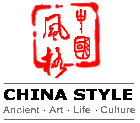Costumes in Watery Regions South of Yangtze
Countryside women living east of Suzhou City of Jiangsu Province still wear the traditional folk clothes and adornments and always wear headcloth, pieced coat, trousers with the waist pieced together and embroidered shoes and so on.
Women in watery regions attach much importance to hairstyles and headwear and try to demonstrate their ingenuity and beauty through their pitch-black hair, big hairpin, many ornaments on the hair, coupled with elegant headcloth and dress.
Their garments feature a very strong local flavor and a stable character to be handed down from one generation to another. However, these garments vary distinctly with changes of seasons, difference in ages and etiquette needs.
Generally speaking clothes for spring and autumn have the most distinctive characteristics. For these clothes, the upper garment is usually a pieced coat, whose material is mostly multicolor cloth, native cloth, or dark and light indanthrene cloth. Their colors feature clear contrast and are bright but not gaudy, gorgeous but not vulgar. Usually, materials of several colors are pieced together. The cutting is properly done and the stitchwork is elaborate. The whole dress is full of decorative design. In a word, clothes for spring and autumn feature pieced stitchwork, piped design, button loops, ornamental strings, embroidery and so on.
As for trousers, they often use white printed cloth on blue background or blue printed cloth on white background; the crotch of trousers is pieced together by using blue or black indanthrene cloth. Originally, dress was made of pieced cloth due to cloth width and for the purpose of saving material. Later, the purpose shifted from a practical need to an artistic creation. In either case, the beauty of neatness, balance and symmetry is taken into consideration.
The skirt around the waist is also very unique: it reaches the knee, has a very thin brace, and various festoonery on both the brace and the girdle; around the skirt there is girdle, which is sewn with a big pocket and embroidered with all kinds of patterns.
The skirt design is very practical. When you wear a Juequn (a kind of skirt) in work, it can protect your waist and back from cold, and add to the strength of your waist when you stand up. The skirt has a big lower hem, which makes it easy to work in the paddy field and also serves as a cover when wearers piss in the field. It is really practical and beautiful as well.
Shoes in watery regions feature a strong local flavor, too. The shoe looks like a boat and has no distinction between left and right. Thus, it is also called boat-shaped embroidered shoe. Its upper is made from two pieces of cloth, and vamp is mainly covered with embroidery, bright in color and varied in pattern. The boat-shaped shoe is fine in workmanship, good looking, strong and practical. It is a traditional kind of shoe worn by women in the watery regions.
Requirements of women's garments vary with different ages. For young women, the dress should be as garish as possible. By making clever use of the limited space in the dress, and using various techniques such as color contrast, background setting-off and interleaving, etc., to achieve a conspicuous and garish effect, the dress highlights the physical beauty and decorative beauty of women in the watery regions, and airs a feeling of being light-footed, free and easy.
However, clothes for middle-aged and old women mainly adopt deep colors so that they look serious and stable. They are also loose and big, giving a sense of primitive simplicity and prudence.


